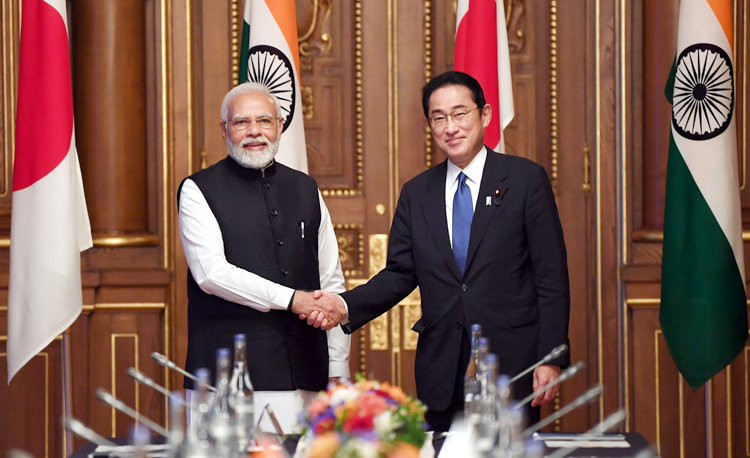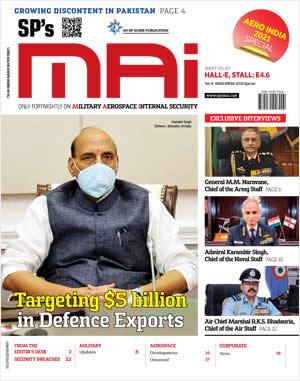INDIAN ARMED FORCES CHIEFS ON OUR RELENTLESS AND FOCUSED PUBLISHING EFFORTS

The insightful articles, inspiring narrations and analytical perspectives presented by the Editorial Team, establish an alluring connect with the reader. My compliments and best wishes to SP Guide Publications.

"Over the past 60 years, the growth of SP Guide Publications has mirrored the rising stature of Indian Navy. Its well-researched and informative magazines on Defence and Aerospace sector have served to shape an educated opinion of our military personnel, policy makers and the public alike. I wish SP's Publication team continued success, fair winds and following seas in all future endeavour!"

Since, its inception in 1964, SP Guide Publications has consistently demonstrated commitment to high-quality journalism in the aerospace and defence sectors, earning a well-deserved reputation as Asia's largest media house in this domain. I wish SP Guide Publications continued success in its pursuit of excellence.
- Operation Sindoor: Resolute yet Restrained
- India’s Operation Sindoor Sends a Clear Message to Terror and the World – ‘ZERO TOLERANCE’
- Japan and India set forth a defence cooperation consultancy framework, talks on tank and jet engines
- Terrorist Attack in Pahalgam in Kashmir: Unfolding a long surgical war against PAK
- Lt General Pratik Sharma takes over Command of Indian Army's Northern Command
Indo-Japanese Air Combat Exercise
The India-Japan joint air combat exercise 'Veer Guardian' will further strengthen bilateral defence cooperation and military interoperability, as also enhance tactical air combat skills of the two sides
 |
The Author is Former Director General of Information Systems and A Special Forces Veteran, Indian Army |

For the first time Japan's Air Self-Defence Force (JASDF) and the Indian Air Force (IAF) will be holding a joint air combat exercise between January 16 and 26, 2023. Earlier in May 2022, Prime Minister Narendra Modi and his Japanese counterpart, Prime Minister Fumio Kishida had agreed that the two nations should arrange a joint exercise involving fighter jets at an early date. India will be the fifth nation to hold joint air combat exercises with the JASDF after the US, Australia, the UK and Germany.
The area of the exercise named “Veer Guardian” will be the Iruma and Hayakuri airbases in Japan and the airspace above them. The JASDF participation will include 4 x F-2 fighter aircraft from the 7th Air Wing and 4 x F-15 fighters from the 6th Air Wing. The IAF participation will include: 4 x Su-30MKI fighters from the 220 Squadron of the 34 Air Wing of the Western Air Command; 2 x C-17 military transport aircraft from 81 Squadron of the 28 Air Wing of Western Air Command, and; total 150 personnel. The Indian contingent will be supported by 2 x C-17 Globemaster III strategic lift aircraft and an Il-78 mid air refueler tanker aircraft from the 78th squadron of the 4th Air Wing of the Central Air Command.
India will be the fifth nation to hold joint air combat exercises with the Japan's Air Self-Defence Force (JASDF)
Since 2015, Japan has regularly participated in the India-US Malabar series of joint naval exercises, which has also been joined now by Australia – the fourth QUAD member. On the bilateral front, India and Japan have already held the joint army exercise ‘Dharma Guardian’ and the joint naval exercise ‘JIMEX’. The India-Japan joint air combat exercise ‘Veer Guardian’ will further strengthen bilateral defence cooperation and military interoperability, as also enhance tactical air combat skills of the two sides. India and Japan have also operationalised their Reciprocal Provision of Supply and Services Agreement, which India already has with the US, Australia, France, Republic of Korea and Singapore.


Excessively aggressive actions by China and North Korea, plus America’s enhanced interactions with Taiwan to the discomfort of China, has raised tensions in the Western Pacific to very high levels. Tokyo has recently adopted a new national security strategy (NSS), the provisions of which can have a huge impact on the security architecture in the Asia-Pacific region. The NSS names China as the main strategic challenge to Japan's security, with North Korea in second place. Russia is also mentioned in the NSS as a country whose actions are of concern.
Tokyo has recently adopted a new national security strategy (NSS), the provisions of which can have a huge impact on the security architecture in the Asia-Pacific region
Most significantly, Japan is to spend Yen 6.82 trillion ($51.4 billion) in defence spending for fiscal year 2023 which is about 1.19 per cent of Japan’s GDP up from 0.96 per cent in 2022. Tokyo plans to increase defence spending to NATO standard of 2 per cent of GDP by 2027 making it the third country, after the US and China, in terms of military spending.


Japan’s focus areas in defence are:
- Command and control and intelligence-related functions; maneuveringand deployment capability, and;
- Sustainability and resilience of the Japan Self-Defence Forces (JSDF).
Priority areas for development include:
- Mass production of longer-range missiles;
- Integrated air and missile defence (IAMD) capabilities;
- Drones, and;
- cross-domain operations capabilities in space, cyberspace, and electromagnetic domains.
The annual China-Russia exercise ‘Marine Interaction’ was held in the East China Sea during December 2022. It included rocket and artillery firing at military targets, as well as the development of joint anti-submarine actions with the use of weapons. Russian participation included the missile cruiser ‘Varyag’, the frigate ‘Marshal Shaposhnikov’, the corvettes ‘Perfect’ and ‘Hero of the Russian Federation Aldar Tsydenzhapov’, as well as the Naval Aviation of the Pacific Fleet of the Russian Federation. China sent two destroyers, two patrol ships, an integrated supply ship, a diesel submarine and naval aviation assets of the PLA Navy.
Tokyo plans to increase defence spending to NATO standard of 2 per cent of GDP by 2027 making it the third country, after the US and China, in terms of military spending
The China-Russia exercise ‘Marine Interaction 2022’ was held in winters in contrast to this exercise held on earlier occasions in the fall or spring – possibly because of the geopolitical situation. The exercise took place near the coast of the southern province of Zhejiang, which is located very close to Taiwan – an obvious signal to the US and Japan. Since 2012, China and Russia have held 10 joint naval exercises, gradually forming a relatively mature and standardized model for the organisation of joint exercises and their methods based on a high degree of mutual trust and deep cooperation.
China and North Korea have responded to what they consider as remilitarisation of Japan - Chinese ships entered the Sea of Japan in December 2022 while North Korea has been firing away missiles. China continues to violate Taiwan’s airspace using a large number of aircraft. According to Sergei Naryshkin, head of the Russian Foreign Intelligence Service, Washington will continue to "rock" the internal political situation in China and cause tension in the Taiwan Strait and on the Korean Peninsula. He further said that the US will continue to try to forcibly impose democracy in other states, "acting in its usual role as the arbiter of the destinies of the peoples of the world".





